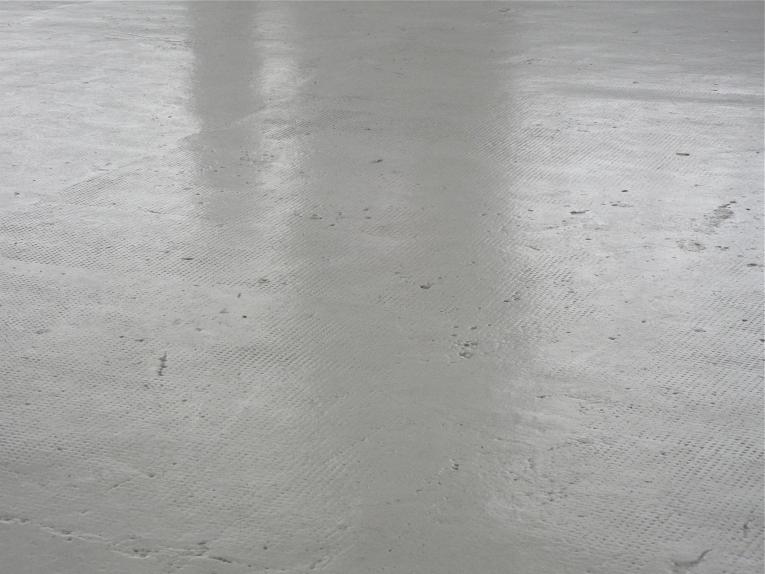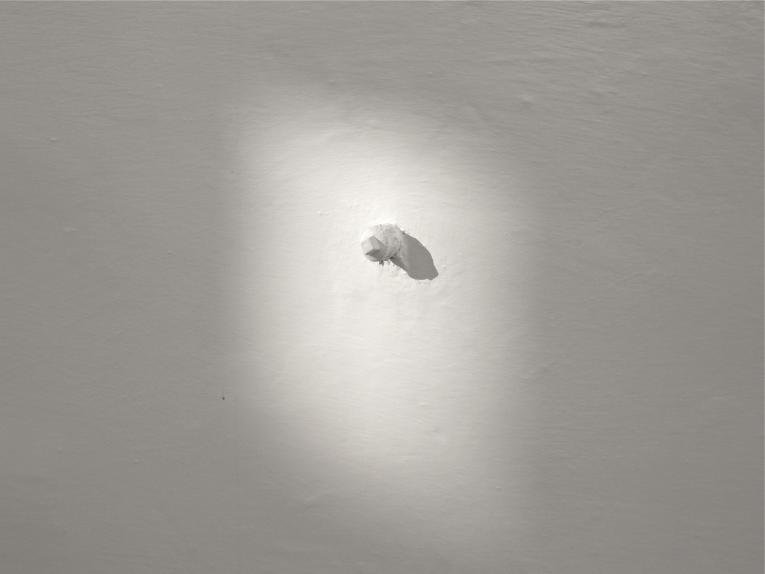killing floor
But those figures that are prone to encounters are the ones who are filled with thoughts – those encounters on vague and disconnected itineraries, during the empty moments when nothing draws our attention, and when one finds oneself among others suspended in time.
(Gianni Celati, 2008)
No face, no name, no number
(the Traffic, 1967)
What I would like to achieve in the space in via Parma 31 primarily concerns a particular phase in the journey of a work of art: that is, when it leaves the artist’s studio and – losing its privacy – it becomes public. That’s what happens when a work is set up in a space other than the studio, and more precisely, a public space: a gallery, a museum, and so on.
During this transitional stage, a new figure takes over (or may take over), a figure one can define in several ways, such as ‘gallery manager’ (intended with a certain meaning), or ‘curator’… I would prefer to use a term borrowed from literature, that I deem more precise and appropriate, the editor - the person who picks up the work while it’s still piping hot, immerses himself in it in order to fully comprehend it, and subsequently suggests certain changes to the author, which the editor may consider necessary in order to set it up – and present it to the public – in the best possible manner. To achieve this, he must first understand it and then choose the best course of action, possibly without superimposing anything personal, and especially anything that could distort the meaning given to the work by the author himself: if ever, any changes should serve the purpose of expressing it at its best.
In recent years, I often pondered on the meaning of mounting an exhibition, in particular a group exhibition, where the challenge consists in creating a new organism formed by different parts which must each be placed in the best possible position, in order to make the whole organism – albeit temporarily – function properly, thus triggering a condition of energy and keeping it going. My experience with e/static enabled me to develop an aptitude for this particular kind of artistic practice, which seems to me especially interesting since it can be linked to the much vaster theme of the landscape: an entity which is generally placed outside the borders of the gallery-space, though it may be represented therein. The landscape is a topic which has been engrossing me for some time now, an extremely vast theme, potentially endless, due to the connections it establishes between history and nature, and which I deem pivotal among those which concern the fundamental matters pertaining to existence. As far as I’m concerned, the issue of mounting – also with relation to a theme such as the landscape – is still open, and it could well lead to the experience of Killing Floor. At least that is what I hope for.
Lately, thinking about the interesting experiment of Solid Void, Progetto Diogene’s ‘school for artists’ – a very singular kind of school – which I had the occasion to follow closely (though I wasn’t involved first-hand), I realized that it pertains the artist himself, as a person, especially during the early stages of his journey, if not even before that. What an artist is, why a person may decide to follow this path (if one can always call it a decision) and which are the issues to discuss, working with the ‘tutors’ to reach some conclusions, or anyway the core of the problem: the artist, or would-be artist, when he is faced with himself, unshielded (because the ‘tutors’ have helped him to cast any shields aside), trying to understand why and how he got where he is and where he could be heading.
Unlike Solid Void, in the project I would like to carry out in via Parma 31 (possibly with a first-hand contribution of the members of Diogene, or at least with those who are personally interested in participating) the work – and not the artist – would be at the forefront, a brand new one[1], fresh from the studio, which would be staged for the first time, thus establishing a connection with the space – thanks to the editor’s mediation – and also with other works already present, or that may be set up more or less at the same time, though never establishing an actual group exhibition. One may rather say that, following a series of subsequent aggregations, a collection of different works would materialize in a single place, in a limited number (since the dimensions of the space would not be sufficient to accommodate many) and in varying quantity, marked by a spirit of mobility and fluidity, so that everything would seem to be constantly changing, as if in a state of suspension.
There may be (actually there are, and are quite evident) some analogies with campo volo, but I think they are mostly superficial, or anyway only limited, because in that case the artist is strictly alone, his work is new and unshowcased, but remains visible to the public only for a few hours, and is subsequently taken down and placed out of sight. On the other hand, in this case, there may be different works by different authors, which would last longer and, during that period of time, they could be partially modified, or even just moved around, in order to establish chance relationships with other exhibits in the space.
The main theme of this school – if we may so call it, thus placing an emphasis on the complementarity or consequentiality with Solid Void – would consist in mounting one or more works of art in a public space; I would participate as the contact person, particularly during the authors’ selection stage, who will also be suggested by the other participants in the project. I would take on the part of the so-called editor, but not in an exclusive manner, since this role would be shared with the artists themselves, each of whom would be able to offer a fresh view of the others’ works.
As a matter of fact, I’m convinced that the works themselves would express their own intrinsic attitudes, as they come into contact with other different works, putting themselves on the line with their own respective, different, languages. Our role – mine and the authors’ – would consist in activating these relocations, or actual changes, dictated by the works themselves.
I spoke of school, and thus, implicitly, of lessons, since I think that it would be interesting to consider addressing – even if only now and then, not on a regular basis - a public which is not only made up of mere onlookers, but rather people who could be genuinely interested, like art school students or other artists. One could arrange dates where the authors are present – with or without the editor – in order to converse and work together (setting up one or more exhibits) in the presence of an audience. In my opinion, this part of the Killing Floor project would be well managed (or co-managed) by Diogene, for its objective consistency with the group’s previous experiences over the last couple of years (especially following the installation of their tram on the roundabout in Corso Verona), first and foremost Solid Void, as mentioned earlier.
Nevertheless, even on these occasions, I would still like Killing Floor to maintain an essentially practical approach, avoiding the employment of e/static as a place for debate, where the spoken word is dominant: in my opinion, the ideal environment for this purpose is the tram instead, the site of choice of Diogene’s projects (Diogene is actually quite close to e/static). The space in via Parma 31, with this new connotation, should rather be a place where one does things, where something happens, without talking about it too much. Instead, words – i.e. debate – wouldn’t certainly be banned (I’d like to avoid any danger of dogmatism..), but they should hold minor importance, or anyway be secondary, mainly instrumental, like a key that is used to open a door to enter another space: afterwards, only the space and what happens therein count, and they should be taken at face value, without the superimposition of too many words.
To be more precise, I’d say that it would be good, actually it would be great, if the author talked about how he created his work, where he started from, that is, what he did or did not have in mind, sharing with the public a very important stage in his journey, which isn’t generally taken much into account, especially by art historians and critics. What I would like to avoid, instead, is the debate on the meaning of the work, that pernicious attitude which materializes with the (too often) recurring question “what does it mean?”.
Because that’s precisely the role that the spoken and written word take on way too often: they are superimposed on the action, or on its results, the works, crystallizing their actual and factual energy, thus bringing to the forefront the mere semantic values, which – at best – serve as surrogates to that energy. They should be able to talk unaided, using their own language, untainted by the ‘universal’ language, the very one which, through writing or speaking, in order to describe or ‘explain’, essentially homogenizes everything, weakening it.
In this workspace, which, as I’m writing this, hasn’t yet come to be, but keeps on growing thanks to my imagination and the conversations with some of my artist friends, the works would all speak at once, like in some sort of conversation, or polyphony – a song for more than one voice, each one different from the other.
At this point I think it’s clear that in via Parma 31, as far as the Killing Floor project is concerned, there won’t be any group exhibitions and, most importantly, there won’t be any curated exhibitions, because there will be no curator. The works themselves, with their mere presence, and above all with their disposition – which won’t be fixed and immutable – will shape the context, a place where different elements will coexist, thus establishing ever-changing connections. In accordance with the programme, the authors will be willing to modify not only the position of their work, but also the shape of the work itself, or at least its attitude towards the other elements present.
However, I wouldn’t want all this to stiffen up the space in via Parma too much. Other events could also take place there, independently from the idea of the school – no matter how ‘peculiar’. Nevertheless, if this place, this interior landscape in constant transformation, had unstable and freely modifiable boundaries, whilst still managing to keep an open space where anyone deemed interesting (by me or by whoever will collaborate with me, mounting the exhibits) – especially as far as Diogene and its members are concerned - can showcase something new, then yes, everything, more or less, would be possible.
Carlo Fossati, 2012 (translation by Valentina Maffucci)
[1] or a hitherto unshowcased one; or the author may want to give fresh meaning to a work which has been previously showcased, and may be even willing to perform some changes to it.



.jpg)


